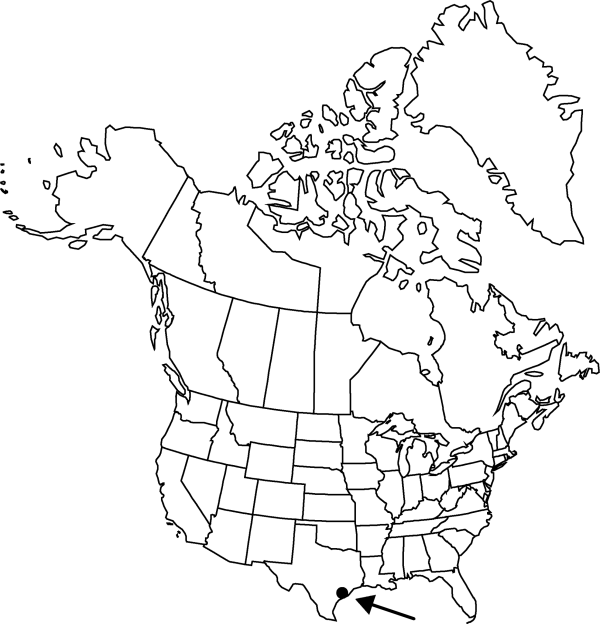Difference between revisions of "Opuntia ellisiana"
Rep. (Annual) Missouri Bot. Gard. 21: 170, plate 25. 1910.
FNA>Volume Importer |
imported>Volume Importer |
||
| (6 intermediate revisions by 2 users not shown) | |||
| Line 6: | Line 6: | ||
|place=21: 170, plate 25. 1910 | |place=21: 170, plate 25. 1910 | ||
|year=1910 | |year=1910 | ||
| + | }} | ||
| + | |special_status={{Treatment/ID/Special_status | ||
| + | |code=I | ||
| + | |label=Introduced | ||
}} | }} | ||
|basionyms= | |basionyms= | ||
| Line 11: | Line 15: | ||
|name=Opuntia lindheimeri var. ellisiana | |name=Opuntia lindheimeri var. ellisiana | ||
|authority=(Griffiths) K. Hammer | |authority=(Griffiths) K. Hammer | ||
| + | |rank=variety | ||
}} | }} | ||
|hierarchy=Cactaceae;Cactaceae subfam. Opuntioideae;Opuntia;Opuntia ellisiana | |hierarchy=Cactaceae;Cactaceae subfam. Opuntioideae;Opuntia;Opuntia ellisiana | ||
| Line 25: | Line 30: | ||
|habitat=Cultivation | |habitat=Cultivation | ||
|distribution=Ariz.;Tex.;Mexico. | |distribution=Ariz.;Tex.;Mexico. | ||
| − | |discussion=<p>Opuntia ellisiana is only known from cultivation in the United States; the type is from a cultivated plant growing in Corpus Christi, Texas.</p><!-- | + | |introduced=true |
| − | --><p>Opuntia ellisiana has been confused with O. ficus-indica; their fruits are readily separable in the number and distribution of areoles and fruit size.</p> | + | |discussion=<p><i>Opuntia ellisiana</i> is only known from cultivation in the United States; the type is from a cultivated plant growing in Corpus Christi, Texas.</p><!-- |
| + | --><p><i>Opuntia ellisiana</i> has been confused with <i>O. ficus-indica</i>; their fruits are readily separable in the number and distribution of areoles and fruit size.</p> | ||
|tables= | |tables= | ||
|references= | |references= | ||
| Line 35: | Line 41: | ||
-->{{#Taxon: | -->{{#Taxon: | ||
name=Opuntia ellisiana | name=Opuntia ellisiana | ||
| − | |||
|authority=Griffiths | |authority=Griffiths | ||
|rank=species | |rank=species | ||
| Line 49: | Line 54: | ||
|publication title=Rep. (Annual) Missouri Bot. Gard. | |publication title=Rep. (Annual) Missouri Bot. Gard. | ||
|publication year=1910 | |publication year=1910 | ||
| − | |special status= | + | |special status=Introduced |
| − | |source xml=https:// | + | |source xml=https://bitbucket.org/aafc-mbb/fna-data-curation/src/2e0870ddd59836b60bcf96646a41e87ea5a5943a/coarse_grained_fna_xml/V4/V4_272.xml |
|subfamily=Cactaceae subfam. Opuntioideae | |subfamily=Cactaceae subfam. Opuntioideae | ||
|genus=Opuntia | |genus=Opuntia | ||
Latest revision as of 22:57, 5 November 2020
Shrubs, low, spreading, to 2 m. Stem segments strongly interconnected, blue-green, flattened, obovate to ovate or circular, 15–25 × 10–20 cm, glaucous, low tuberculate, glabrous; areoles 5–7 per diagonal row across midstem segment, often fan-shaped with small circular extensions at base, 2.5–5(–10) mm diam., base surrounded by glabrous yellow lip; wool white, aging blackish. Spines absent or vestigial, yellow. Glochids few, scattered, poorly developed, yellow, aging gray to blackish, to 1.5 mm, covered by white, cottony wool. Flowers: inner tepals brilliant yellow throughout, fading orange to red, 25–30 mm; filaments white to green; anthers yellow; style white; stigma lobes bright light green. Fruits pink- to red-purple with red pulp, pyriform, 30 × 25 mm, fleshy, glabrous, spineless; areoles 18–25, usually crowded near apex, long, white woolly. Seeds tan, subcircular, 2 mm diam.; girdle broad, projecting 0.5 mm. 2n = 22.
Phenology: Flowering spring (May–Jun).
Habitat: Cultivation
Distribution

Introduced; Ariz., Tex., Mexico.
Discussion
Opuntia ellisiana is only known from cultivation in the United States; the type is from a cultivated plant growing in Corpus Christi, Texas.
Opuntia ellisiana has been confused with O. ficus-indica; their fruits are readily separable in the number and distribution of areoles and fruit size.
Selected References
None.